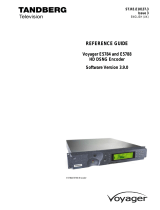
User’s manual · ETWF 310
- 17 - ETWF 310 version_en_1.1 FTE maximal
Useful channel capacity (8 MHz)
Guad Interval
Modulation FEC codification
1/4 1/8 1/16 1/32
1/2 4.976 5.529 5.855 6.032
2/3 6.635 7.373 7.806 8.043
3/4 7.465 8.294 8.782 9.048
5/6 8.294 9.216 9.758 10.053
QPSK
7/8 8.709 9.676 10.246 10.556
1/2 9.953 11.059 11.709 12.064
2/3 13.271 14.745 15.612 16.086
3/4 14.929 16.588 17.564 18.096
5/6 16.588 18.431 19.516 20.107
16-QAM
7/8 17.418 19.353 20.491 21.112
1/2 14.929 16.588 17.564 18.096
2/3 19.906 22.118 23.419 24.128
3/4 22.394 24.882 26.346 27.144
5/6 24.882 27.647 29.273 30.16
64-QAM
7/8 26.126 29.029 30.737 31.668
Useful channel capacity (7 MHz)
Guad Interval
Modulation FEC codification
1/4 1/8 1/16 1/32
1/2 4.354 4.838 5.123 5.278
2/3 5.806 6.451 6.83 7.037
3/4 6.532 7.257 7.684 7.917
5/6 7.257 8.064 8.538 8.797
QPSK
7/8 7.62 8.467 8.965 9.237
1/2 8.709 9.676 10.246 10.556
2/3 11.612 12.902 13.661 14.075
3/4 13.063 14.515 15.369 15.834
5/6 14.515 16.127 17.076 17.594
16-QAM
7/8 15.24 16.934 17.93 18.473
1/2 13.063 14.515 15.369 15.834
2/3 17.418 19.353 20.491 21.112
3/4 19.595 21.772 23.053 23.751
5/6 21.772 24.191 25.614 26.39
64-QAM
7/8 22.861 25.401 26.895 27.71
Useful channel capacity (6 MHz)
Guad Interval
Modulation FEC codification
1/4 1/8 1/16 1/32
1/2 3.732 4.147 4.391 4.524
2/3 4.976 5.529 5.855 6.032
3/4 5.599 6.221 6.587 6.786
5/6 6.221 6.912 7.318 7.54
QPSK
7/8 6.532 7.257 7.684 7.917
1/2 7.465 8.294 8.782 9.048
2/3 9.953 11.059 11.709 12.064
3/4 11.197 12.441 13.173 13.572
5/6 12.441 13.824 14.637 15.08
16-QAM
7/8 13.063 14.515 15.369 15.834
1/2 11.197 12.441 13.173 13.572
2/3 14.929 16.588 17.564 18.096
3/4 16.796 18.662 19.76 20.358
5/6 18.662 20.735 21.955 22.62
64-QAM
7/8 19.595 21.772 23.053 23.751
Useful channel capacity (5 MHz)
Guad Interval
Modulation Codificación FEC
1/4 1/8 1/16 1/32
1/2 3.110 3.456 3.659 3.770
2/3 4.147 4.608 4.879 5.027
3/4 4.665 5.184 5.489 5.655
5/6 5.184 5.760 6.099 6.283
QPSK
7/8 5.443 6.048 6.404 6.598
1/2 6.221 6.912 7.318 7.540
2/3 8.294 9.216 9.758 10.053
3/4 9.331 10.368 10.978 11.310
5/6 10.368 11.520 12.197 12.567
16-QAM
7/8 10.886 12.096 12.807 13.195
1/2 9.331 10.368 10.978 11.310
2/3 12.441 13.824 14.637 15.080
3/4 13.996 15.551 16.466 16.965
5/6 15.551 17.279 18.296 18.850
64-QAM
7/8 16.329 18.143 19.211 19.793
Note: Only aplicable for DVB-H.






















